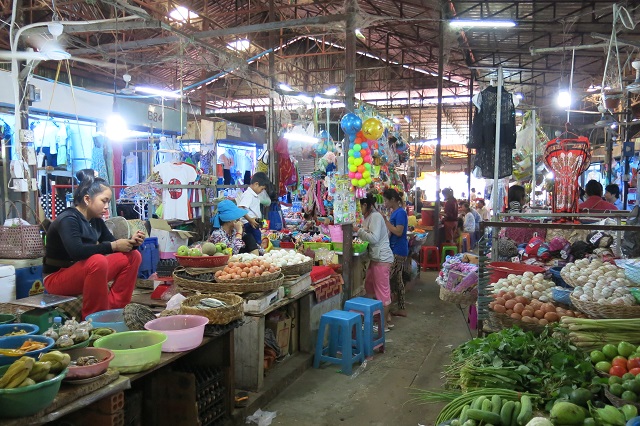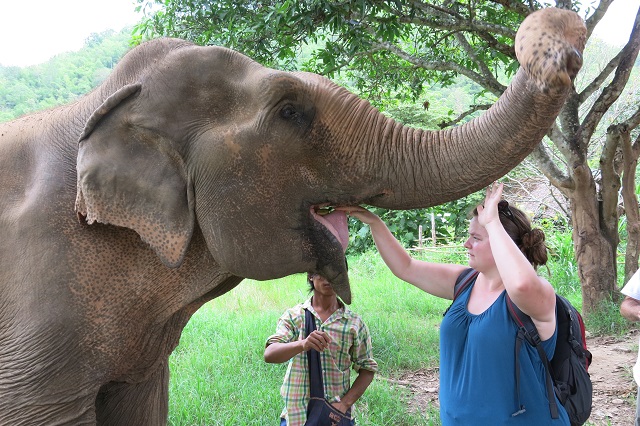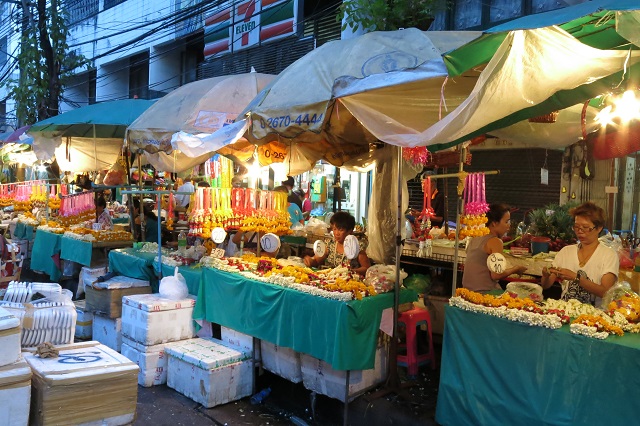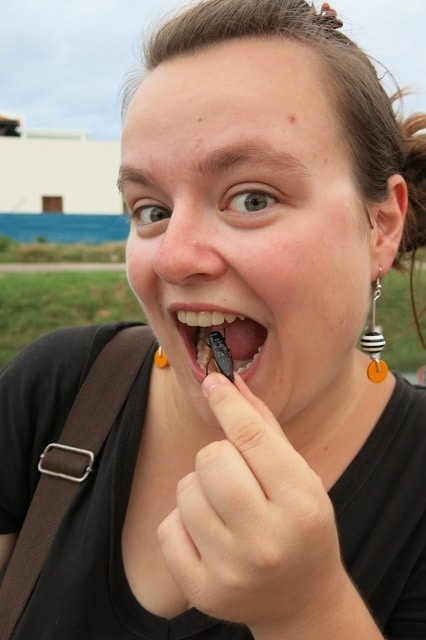Culture Enthusiast Jennifer Doré Dallas Tells Us How To Get Off The Tourist Trail In Southeast Asia
Planning a trip to Southeast Asia? Avid traveler and blogger at Moi, mes souliers Jennifer Doré Dallas of tells us where to eat like a local, ways to stay safe and how to get off the tourist trail to experience and have an authentic cultural experience in Southeast Asia.
1. Please tell us a bit about your travels in Southeast Asia. What brought you there and what kinds of experiences did you end up having?
Southeast Asia was the second half of my 9-month trip that first landed me in South America. I have to admit, I didn't really think I would like Asia, as I've never been inclined to visit it, but I figured if I was going to discover the world, this was a huge chunk I just couldn't leave out. Boy, was I ever surprised. Asia is now my favorite continent!
My time there mostly revolved around food; it's just a perfect place to eat great food at ridiculously cheap prices and to explore hidden markets all day long. It kept me on my toes and I really like the respectful spirituality of Southeast Asians. It has a very "live and let live" philosophy, but it still has a way of getting to you, as everything is different in its own way.
2. What's one attraction or experience in Southeast Asia you recommend that a person probably won't find in their guidebook?
Most markets are in guidebooks, but I really recommend asking the locals where they go instead of following the crowds. We did just that in Bangkok and ended up almost lost in this maze of flowers, food and animals being sold at tons of colorful stands. We would never have stumbled upon it; it was out of the way and, honestly, I don't know if I could find it again; however, it was an incredible experience, as we were the only tourists there and people were so friendly, because they knew we were really interested in discovering their culture, not the tourist-facing one.
3. For those wanting to experience local culture in Southeast Asia, what are some top recommendations?
I'm really big on asking the locals. I always have a guidebook on my laptop, but I read it and then kind of forget about it. People are the culture, so try to talk to them, especially considering that a lot of Southeast Asians speak sufficient English to have an interesting conversation.
Ask questions, it's the only way to find out more, as they'll tell you what most tourists want to hear. But if you ask questions, you'll dive deeper into their daily life and reality.
If you are uncertain about how to go about exploring, there are some different tours out there than enable you to visit things while seeing them in a new light. For example, instead of riding an elephant, go to the Elephant Nature Park to understand instead of being part of the problem, invite a local to show you his favorites (like the hostel employee you've become friends with), take a bike tour instead of a huge tourist bus, etc.
4. No trip to Southeast Asia would be complete without savoring the culinary culture. During your travels through Southeast Asia what was the culinary mecca in your opinion and what did you eat and drink there?
It's so hard to choose one place. The countries I've visited in Southeast Asia (Thailand, Singapore, Vietnam, Cambodia and Malaysia) are all foodie hubs! I had a great time in Thailand discovering new foods, but I'd have to pick Cambodia as my favorite. Their dishes are most often simple, but they knock your socks off. I went on multiple food experiences and I would go back any day for some fish amok!
They do have some surprising customs though, like eating grasshoppers and worms like chips (shown below), frying spiders and eating duck embryos (balut like in the Philippines), which I kind of stayed away from, but their traditional food scene is going through a revival and it needs to be experienced soon!
5. What's one thing that surprised you about Southeast Asia as a destination?
It's actually easy to be there! I used to see Southeast Asia as such a faraway place with no commodities, hard to get around, presenting a huge language barrier. I discovered that it's quite easy to get around, to connect with people and to still be able to move out of the beaten track when you're sick of guesthouses full of tourists.
6. Tell us about one of your most memorable unexpected adventures in Southeast Asia.
That's not easy, there are many moments I'd love to relive again and again, but I'd have to say my Siem Reap food tour. I was expecting a traditional market food tour which I had been invited to try, but a dozen tour guides showed up instead. It was actually a training night for them, so I was with a bunch of Cambodians looking to have a good time and discover what the food guide normally shows at the market so they could reproduce it on a future tour.
We had so much fun, as everyone was buying snacks and food as we went along, so I got to taste just about everything you could think of. Normally on a food tour you get to taste a few things or you can buy extra, but as a foreigner not knowing if I'll like it, I'm sometimes afraid to buy bigger quantities that I might waste. This time, that wasn't a problem.
One of the ladies and I even had a balloon dart competition and the loser had to eat balut! I was so happy I won and got to watch her eat it, as I just couldn't stomach it, but we laughed so much and everyone got into the action and started cheering and just plain having a great time. It was more like an outing with friends than a tour and I got to immerse myself in a bit of their daily life, which was simply awesome.
7. What are some of the cultural taboos travelers heading to Southeast Asia should be aware of?
My main tip would be to just observe. "When in Rome," as they say. If you're doing the same as a local, you should be okay. Try to adapt and see what's happening. Most people will forgive you if you make a mistake as long as you show general respect towards them and their culture.
Watch your feet! Always remove shoes before entering most sacred places and homes, as it's a custom in most SEA countries. In some places, you also have to make sure you don't turn the soles of your feet towards Buddha or locals.
Cover yourself, especially your shoulders and knees as SE Asians dress appropriately even if it's scorching hot (which you'll notice they seem to be able to ignore). It's just out of place to walk around in your bikini top and tight shorts.
Keep your cool. Losing it and being impatient or screaming at locals will get you nowhere. If you keep a smile on your face — even if it's the 100th time you repeat something — you are more likely to get what you want, because they will not "lose face" from your impatience. It's really important to them to "maintain face" publicly, and our North American attitudes sure don't work there as they can bring shame upon them (although it should be on us!).
8. In terms of safety, what are some tips you'd recommend to travelers heading to Southeast Asia?
I felt generally very safe in Southeast Asia in regards to my physical self, even traveling as a solo female, but I can't say as much about my money. But then again, what's losing a couple bucks in comparison to feeling safe to walk down pretty much any street?
I think the usual safety precautions apply, like keeping your stuff locked up when possible, not keeping big amounts of money on you, keeping copies of all your important papers, etc.
The main focus in Southeast Asia is to stay smart. It's so easy to get conned. When you think you've seen it all, something new comes up. You can't be naïve — they know all the tricks — but if you go with your gut and listen to your instincts, you'll be okay. Or in the worst case, you'll overpay, which isn't that dramatic in the end.
9. Traveling through Southeast Asia, what were some major adjustments you had to make to your daily lifestyle?
Being a blogger I was also working on the road, so my main adjustment was to the Wi-Fi conditions. Some places had better connections than in Montreal, while others just made me want to pull my hair out. When you're checking Facebook, that's fine, but when you need to get stuff done, it's not all that fun.
Don't plan things too perfectly. If you do, you'll be disappointed. There is a saying about Caribbean time, but I think Southeast Asian time is worse. If you're patient you'll be okay, but give yourself enough time not to miss bus connections or not to arrive in the middle of the night if the bus breaks down. You can bet that the only time the bus will leave on time is when you're late to get to it though!
10. What's one lesser-known destination in Southeast Asia you'd recommend to travelers and why?
I think Southeast Asia is pretty well-known these days, but in each country there is a way to escape the gringo trail and see new, more original things. The country where that was the easiest in my opinion was Cambodia, where there are still many unexplored parts. The people are so friendly and smiley when you venture out of the tourist traps and you'll have a blast trying new things.
About Jennifer Doré Dallas
In 2013, Jennifer saw her thirties coming full speed ahead so she decided to ditch the corporate world, commit to blogging fulltime and leave on a 9-month adventure to see more of the world. A backpacker with a tendency for luxury escapes, she's a paparazza and foodie that has seen 35 countries so far. At home both in hostels and 5-star hotels, she's just as much of a sandwich on the go girl as a sit-down full course meal type. She's got a thing for Ziplocs and hates umbrellas. Follow her adventures at Moi, mes souliers or on Twitter, Facebook, Google+ and Pinterest.
The post Culture Enthusiast Jennifer Doré Dallas Tells Us How To Get Off The Tourist Trail In Southeast Asia appeared first on Epicure & Culture.




